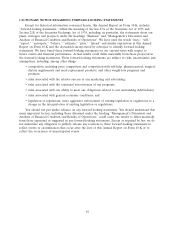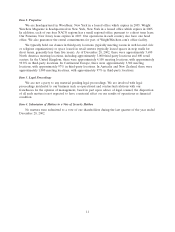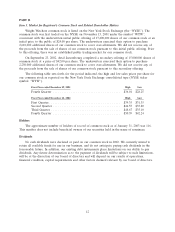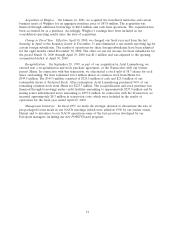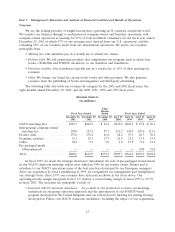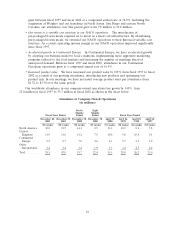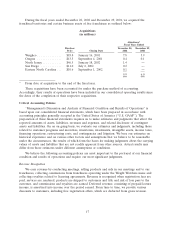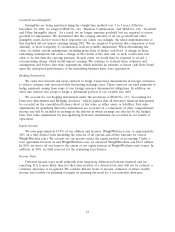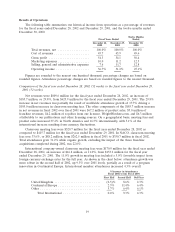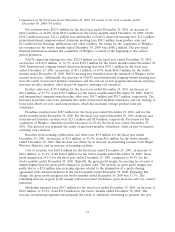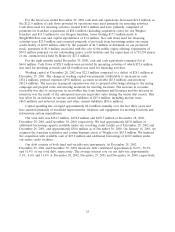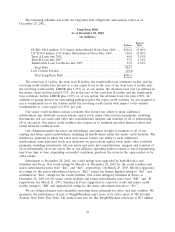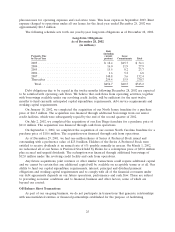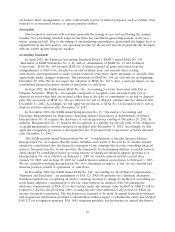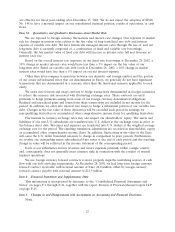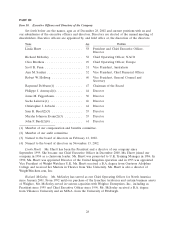WeightWatchers 2002 Annual Report Download - page 25
Download and view the complete annual report
Please find page 25 of the 2002 WeightWatchers annual report below. You can navigate through the pages in the report by either clicking on the pages listed below, or by using the keyword search tool below to find specific information within the annual report.Goodwill and Intangibles
Intangibles are being amortized using the straight-line method over 3 to 5 years. Effective
December 30, 2001, we adopted SFAS No. 141, ‘‘Business Combinations’’ and SFAS No. 142, ‘‘Goodwill
and Other Intangible Assets.’’ As a result, we no longer amortize goodwill, but are required to review
goodwill for impairment. We determined that the carrying amounts of all our goodwill and other
intangible assets did not exceed their respective fair values. Accordingly, the initial implementation of
this standard did not impact earnings during 2002. We are required to perform this comparison at least
annually, or more frequently if circumstances indicate possible impairment. When determining fair
value, we utilize various assumptions, including projections of future cash flows. A change in these
underlying assumptions will cause a change in the results of the tests and, as such, could cause fair
value to be less than the carrying amounts. In such event, we would then be required to record a
corresponding charge, which would impact earnings. We continue to evaluate these estimates and
assumptions and believe that these assumptions, which included an estimate of future cash flows based
upon the anticipated performance of the underlying business units, were appropriate.
Hedging Instruments
We enter into forward and swap contracts to hedge transactions denominated in foreign currencies
to reduce currency risk associated with fluctuating exchange rates. These contracts are used primarily to
hedge payments arising from some of our foreign currency denominated obligations. In addition, we
enter into interest rate swaps to hedge a substantial portion of our variable rate debt.
We account for our hedging instruments under the provisions of SFAS No. 133, ‘‘Accounting for
Derivative Instruments and Hedging Activities,’’ which requires that all derivative financial instruments
be recorded on the consolidated balance sheet at fair value as either assets or liabilities. Fair value
adjustments for qualifying derivative instruments are recorded as a component of other comprehensive
income and will be included in earnings in the periods in which earnings are affected by the hedged
item. Fair value adjustments for non-qualifying derivative instruments are recorded in our results of
operations.
Equity Investee
We own approximately 19.9% of our affiliate and licensee, WeightWatchers.com, or approximately
38% on a fully diluted basis (including the exercise of all options and all the warrants we own in
WeightWatchers.com.) We account for our interest under the equity method of accounting. Under a
loan agreement between us and WeightWatchers.com, we advanced WeightWatchers.com $34.5 million.
In 2001, we wrote off our loans to the extent of our equity interest in WeightWatchers.com’s losses. In
addition, in 2001, we fully reserved for the remaining loan balance.
Income Taxes
Deferred income taxes result primarily from temporary differences between financial and tax
reporting. If it is more likely than not that some portion of a deferred tax asset will not be realized, a
valuation allowance is recognized. We consider historic levels of income, estimates of future taxable
income and feasible tax planning strategies in assessing the need for a tax valuation allowance.
18




